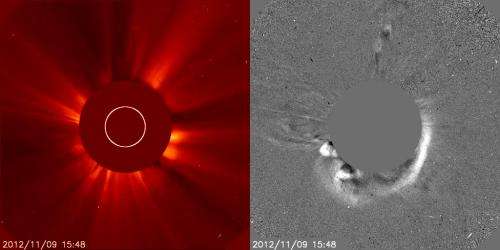Sun releases slow moving CME

On Nov. 9, 2012, at 10:24 a.m. EST, the sun emitted an Earth-directed coronal mass ejection (CME). A CME is a solar phenomenon that can send billions of tons of solar particles into space and can reach Earth one to three days later. CMEs can affect electronic systems in satellites and on the ground.
Experimental NASA research models based on observations from NASA's Solar Terrestrial Relations Observatory (STEREO) and the joint ESA/NASA Solar Heliospheric Observatory (SOHO) show that the CME left the sun traveling at 350 miles per second, which is a slow to average speed for CMEs.
Geomagnetic storms can occur when certain types of CMEs connect up with the outside of the Earth's magnetic envelope, the magnetosphere, for an extended period of time. In the past CMEs of this magnitude have tended to have a relatively weak impact, perhaps causing auroras near the poles, but not causing damage to electrical systems on Earth or interfering with GPS or satellite-based communications systems.
NOAA's Space Weather Prediction Center (swpc.noaa.gov) is the United States Government official source for space weather forecasts.
Updates will be provided as needed.
More information: What is a CME? For answers to this and other space weather questions, please visit the Spaceweather Frequently Asked Questions page.
Provided by NASA




















